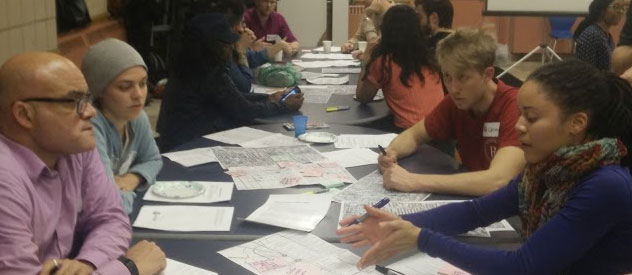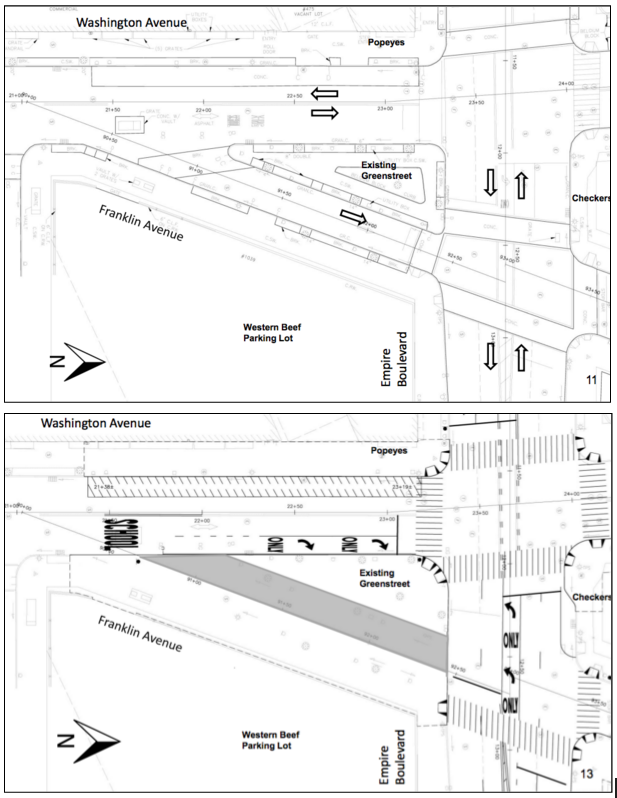
Last night, Transportation Alternatives’ Brooklyn Activist Committee and the Prospect Lefferts Gardens Neighborhood Association hosted a #SlowDownPLG workshop for neighborhood residents to share ideas about walking and biking safety in the neighborhood. Around 35 people attended and worked in small groups to address concerns on five streets: Ocean Avenue, Flatbush Avenue, Rogers Avenue, Nostrand Avenue, and Empire Boulevard.
Excessive speeding and a lack of effective bike infrastructure were among people's top concerns. Daniel Kristjansson, a TA volunteer who also serves on the CB 9 transportation committee, shared a TA-initiated study that showed 80 percent of all drivers on Rogers Avenue speed, with the worst offenders going more than twice the 25 mph limit. Rogers, like many streets in the neighborhood, is also plagued by double-parking and drivers blowing through red lights.
The one north-south bike lane in the neighborhood is on Bedford Avenue, but cyclists last night said they avoid Bedford because of speeding motorists, poor lighting, and the steep incline.
Within Prospect Lefferts Gardens, Nostrand, Flatbush, and Franklin avenues are all priority corridors in DOT’s Vision Zero borough action plan, meaning they are especially dangerous. Fatal crashes in both Prospect Lefferts Gardens and Crown Heights are all too common, but Community Board 9 has been in disarray, and DOT hasn't done much to improve street design in the area.

In September, DOT and the Department of Design and Construction presented the Empire Boulevard Reconstruction Project [PDF] to CB 9. Conceived in 2013 with funding from the Department of Environmental Protection and the late Congressman Major Owens, the project would rebuild most of Empire Boulevard and turn slip lanes at each end of the neighborhood, where drivers can take turns at dangerous speeds, into sidewalk space.
The proposal has since been swept up in the heated debate over the rezoning of Empire Boulevard. In a neighborhood where rents are rising, physical changes to the street can provoke anxiety about the escalating cost of living. But the specific complaints about the Empire Boulevard project are mostly just related to traffic and parking, despite the fact that barely one-third of neighborhood residents own a car.
While the CB 9 transportation committee voted 4-0 in September to approve the plan, the full board kicked it back to the committee after a contentious meeting in November. The committee chair at the time was removed from the post, and the committee has been unable to come to any conclusion on the project. The proposal will now come before the full board at its April meeting, according to CB 9 Chair Demetrius Lawrence.
If the fate of the project depends on the support of Community Board 9, it’s probably doomed. The new pedestrian areas would result in a loss of seven parking parking spaces, which was the main topic of discussion on Monday, when the transportation committee took up the project again. "That triangle is fine just like it is," committee member Karen Fleming said. "With what’s going on, we feel like there’s a master plan."

Another discussion of Utica Avenue Select Bus Service, which will speed up trips for tens of thousands of bus riders each day, centered mostly on the city’s supposed quest to rake in as much money as possible from bus lane camera enforcement.
In August, DOT Deputy Commissioner Ryan Russo cited gentrification politics when explaining DOT's reluctance to add bike lane projects in the neighborhood. “Have you read any coverage of CB 9? They are literally disintegrating because of gentrification. Literally disintegrating,” Russo said at the time.
Speaking to Streetsblog this afternoon, #SlowDownPLG organizer Cal DeJesus, who recently joined the transportation committee, said she hopes last night and future events can show CB 9 that there is strong support in the neighborhood for street safety measures.
"By holding these community workshop forums, we're hoping to show actual numbers and actually gather more of the community's support because these people on the committee, we're supposed to represent the community members overall," DeJesus said. "And it just doesn't seem the decisions they're making are reflective of what the community wants."





